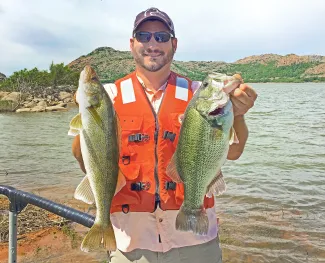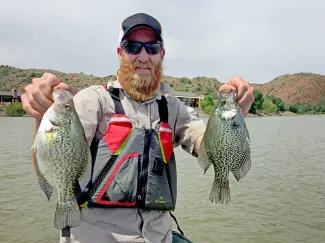
"Come on down! The fishing's good!"
Those are the encouraging words coming from anglers this spring at Lake Altus-Lugert in southwestern Oklahoma -- especially encouraging since the lake was rendered practically lifeless at least two times in the past five years by toxic golden algae blooms.
"We've heard from many anglers as well as our game wardens that people are having good fishing success," said Ryan Ryswyk, Southwest Region supervisor in the Fisheries Division of the Oklahoma Department of Wildlife Conservation. "I'm happy that the lake has made a recovery and we are keeping our fingers crossed that the golden algae won't bloom again anytime soon."
But anglers should also remember that another toxic golden algae bloom could occur anytime.
Fisheries Chief Barry Bolton said he couldn't be more proud of the biologists and technicians who have put extra emphasis on Altus-Lugert to enable recovery.
"We're very pleased that the Altus-Lugert fishery has recovered quickly and again is a fishing destination in southwestern Oklahoma," Bolton said. "It's back!"
"This would not have been possible without the great efforts of the Southwest Region Fisheries personnel who stocked fish, monitored populations and are now seeing the successful results of their efforts."
Ryswyk said fish sampling this past autumn indicated that recovery was in full swing.
"We've had several growing seasons with no fish kill from golden algae. Our sampling showed that the fishery is recovering and I'd say thriving right now."
Altus-Lugert suffered its first golden algae bloom in winter 2012-13, at the height of a severe drought when water in the lake was extremely low. The toxic outbreak killed nearly every fish in the lake, biologists said at the time. The Department quickly developed a plan to address the lake's future and began stocking various fish species.
By spring 2014, biologists were encouraged by fish sampling results. But another deadly golden algae bloom struck in summer 2014, and the 6,400-acre impoundment in the Quartz Mountains again was left mostly lifeless.
But the fish stocking that began right after the first bloom has continued since. "We have stocked shad, sunfish, channel catfish, walleye and crappie," Ryswyk said. "Many other species have washed in from upstream."
He said the lake has had several growing seasons without any fish kills from golden algae. And recent fish sampling indicates many fish species are now eating and growing well.
"All of the sport fish we sampled are in great body condition, or plump. The walleye population is the real standout right now. We had high catch rates last fall, and growth rates were very good as well.
Walleye are reaching 18 inches in only two growing seasons, Ryswyk said.
"We know that we can never completely get rid of the algae once it's in a system, but I'm very pleased to see we have not just a viable, but a booming, fishery right now."
